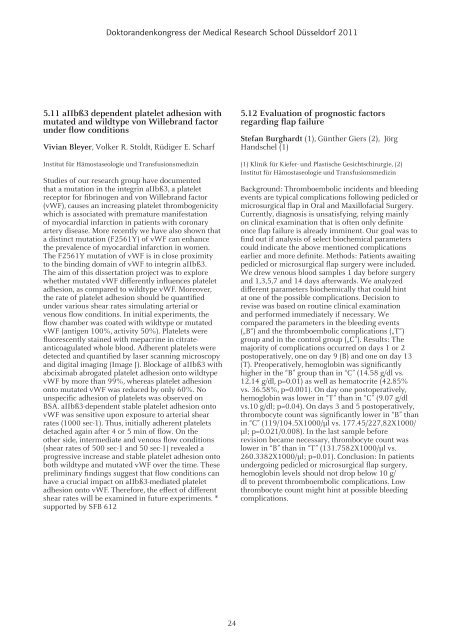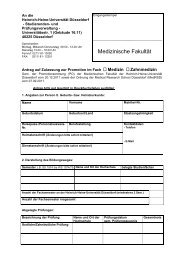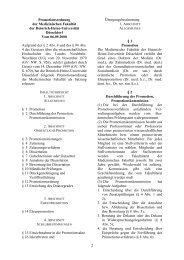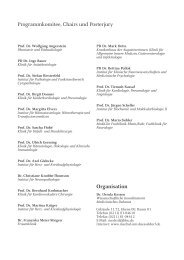34 Seiten als pdf - MedRSD - Heinrich-Heine-Universität Düsseldorf
34 Seiten als pdf - MedRSD - Heinrich-Heine-Universität Düsseldorf
34 Seiten als pdf - MedRSD - Heinrich-Heine-Universität Düsseldorf
Erfolgreiche ePaper selbst erstellen
Machen Sie aus Ihren PDF Publikationen ein blätterbares Flipbook mit unserer einzigartigen Google optimierten e-Paper Software.
Doktorandenkongress der Medical Research School <strong>Düsseldorf</strong> 2011<br />
5.11 aIIbß3 dependent platelet adhesion with<br />
mutated and wildtype von Willebrand factor<br />
under fl ow conditions<br />
Vivian Bleyer, Volker R. Stoldt, Rüdiger E. Scharf<br />
Institut für Hämostaseologie und Transfusionsmedizin<br />
Studies of our research group have documented<br />
that a mutation in the integrin aIIbß3, a platelet<br />
receptor for fi brinogen and von Willebrand factor<br />
(vWF), causes an increasing platelet thrombogenicity<br />
which is associated with premature manifestation<br />
of myocardial infarction in patients with coronary<br />
artery disease. More recently we have <strong>als</strong>o shown that<br />
a distinct mutation (F2561Y) of vWF can enhance<br />
the prevalence of myocardial infarction in women.<br />
The F2561Y mutation of vWF is in close proximity<br />
to the binding domain of vWF to integrin aIIbß3.<br />
The aim of this dissertation project was to explore<br />
whether mutated vWF diff erently infl uences platelet<br />
adhesion, as compared to wildtype vWF. Moreover,<br />
the rate of platelet adhesion should be quantifi ed<br />
under various shear rates simulating arterial or<br />
venous fl ow conditions. In initial experiments, the<br />
fl ow chamber was coated with wildtype or mutated<br />
vWF (antigen 100%, activity 50%). Platelets were<br />
fl uorescently stained with mepacrine in citrateanticoagulated<br />
whole blood. Adherent platelets were<br />
detected and quantifi ed by laser scanning microscopy<br />
and digital imaging (Image J). Blockage of aIIbß3 with<br />
abciximab abrogated platelet adhesion onto wildtype<br />
vWF by more than 99%, whereas platelet adhesion<br />
onto mutated vWF was reduced by only 60%. No<br />
unspecifi c adhesion of platelets was observed on<br />
BSA. aIIbß3-dependent stable platelet adhesion onto<br />
vWF was sensitive upon exposure to arterial shear<br />
rates (1000 sec-1). Thus, initially adherent platelets<br />
detached again after 4 or 5 min of fl ow. On the<br />
other side, intermediate and venous fl ow conditions<br />
(shear rates of 500 sec-1 and 50 sec-1) revealed a<br />
progressive increase and stable platelet adhesion onto<br />
both wildtype and mutated vWF over the time. These<br />
preliminary fi ndings suggest that fl ow conditions can<br />
have a crucial impact on aIIbß3-mediated platelet<br />
adhesion onto vWF. Therefore, the eff ect of diff erent<br />
shear rates will be examined in future experiments. *<br />
supported by SFB 612<br />
24<br />
5.12 Evaluation of prognostic factors<br />
regarding fl ap failure<br />
Stefan Burghardt (1), Günther Giers (2), Jörg<br />
Handschel (1)<br />
(1) Klinik für Kiefer- und Plastische Gesichtschirurgie, (2)<br />
Institut für Hämostaseologie und Transfusionsmedizin<br />
Background: Thromboembolic incidents and bleeding<br />
events are typical complications following pedicled or<br />
microsurgical fl ap in Oral and Maxillofacial Surgery.<br />
Currently, diagnosis is unsatisfying, relying mainly<br />
on clinical examination that is often only defi nite<br />
once fl ap failure is already imminent. Our goal was to<br />
fi nd out if analysis of select biochemical parameters<br />
could indicate the above mentioned complications<br />
earlier and more defi nite. Methods: Patients awaiting<br />
pedicled or microsurgical fl ap surgery were included.<br />
We drew venous blood samples 1 day before surgery<br />
and 1,3,5,7 and 14 days afterwards. We analyzed<br />
diff erent parameters biochemically that could hint<br />
at one of the possible complications. Decision to<br />
revise was based on routine clinical examination<br />
and performed immediately if necessary. We<br />
compared the parameters in the bleeding events<br />
(„B“) and the thromboembolic complications („T“)<br />
group and in the control group („C”). Results: The<br />
majority of complications occurred on days 1 or 2<br />
postoperatively, one on day 9 (B) and one on day 13<br />
(T). Preoperatively, hemoglobin was signifi cantly<br />
higher in the “B” group than in “C” (14.58 g/dl vs.<br />
12.14 g/dl, p=0.01) as well as hematocrite (42.85%<br />
vs. 36.58%, p=0.001). On day one postoperatively,<br />
hemoglobin was lower in “T” than in “C” (9.07 g/dl<br />
vs.10 g/dl; p=0.04). On days 3 and 5 postoperatively,<br />
thrombocyte count was signifi cantly lower in “B” than<br />
in “C” (119/104.5X1000/μl vs. 177.45/227,82X1000/<br />
μl; p=0.021/0.008). In the last sample before<br />
revision became necessary, thrombocyte count was<br />
lower in “B” than in “T” (131.7582X1000/μl vs.<br />
260.3382X1000/μl; p=0.01). Conclusion: In patients<br />
undergoing pedicled or microsurgical fl ap surgery,<br />
hemoglobin levels should not drop below 10 g/<br />
dl to prevent thromboembolic complications. Low<br />
thrombocyte count might hint at possible bleeding<br />
complications.







